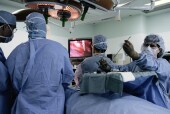 |
 |
 |
||
    |
||||
|
||||

Robotic Surgery Practical for Some Head, Neck Tumors
But more research needed to define advantages, limits of procedure, study suggests|
|
HealthDay
By Robert Preidt
Monday, April 20, 2009
 MONDAY, April 20 (HealthDay News) -- Robot-assisted surgery may be useful for removal of certain head and neck cancers, U.S. researchers say.
MONDAY, April 20 (HealthDay News) -- Robot-assisted surgery may be useful for removal of certain head and neck cancers, U.S. researchers say.
Their study included 36 patients with oral cavity, throat or larynx tumors. Of those patients, 29 (81 percent) underwent successful robotic-assisted surgical removal of the cancerous tissue. Negative margins (when no cancer cells are found at the edge or border of the removed tissue) were obtained in all of those 29 patients. The average operating time was 99 minutes, and the average hospital stay was 2.9 days.
Patients with smaller tumors and no teeth appeared more likely to have successful robot-assisted surgery, noted Dr. Bridget A. Boudreaux and colleagues at the University of Alabama at Birmingham.
The study was published in the April issue of the Archives of Otolaryngology -- Head & Neck Surgery.
"The surgical robot has several advantages over traditional endoscopic and open [surgery] approaches, including three-dimensional visualization, tremor filtration [steadying of any shaking in the surgeon's hands] and greater freedom of instrument movement," the researchers wrote. "These advantages were appreciated in this study and offered good lesion visualization, short hospital stay and good functional preservation."
Currently, there are no clinical guidelines for robotic-assisted surgery in head and neck cancer patients.
"This clinical series demonstrates that robotic surgery can be utilized successfully in patients with T1 to T4 lesions located in the oral cavity, oropharynx [back of the mouth], hypopharynx [bottom of the throat] and larynx with good preservation of swallow function," the study authors concluded.
But this study doesn't "confirm oncologic or functional superiority to any standard method of treatment. Further studies are needed to define the indications, advantages, limitations and outcomes of robotic surgery for head and neck applications."
HealthDay
Copyright (c) 2009 ScoutNews, LLC. All rights reserved.
Related News:
More News on this Date
Related MedlinePlus Pages:
| Home | Health Topics | Drugs & Supplements | Encyclopedia | Dictionary | News | Directories | Other Resources | |
| Disclaimers | Copyright | Privacy | Accessibility | Quality Guidelines U.S. National Library of Medicine, 8600 Rockville Pike, Bethesda, MD 20894 National Institutes of Health | Department of Health & Human Services |
Date last updated: 21 April 2009 |
